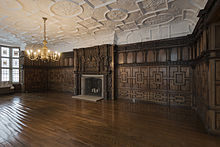

The Rotherwas Room in the Mead Art Museum is over 400 years old. According to the Mead, the intricate wood panels that constitute the room have meandered from an English castle to a New York City gallery to Amherst over the last few centuries. The panels were commissioned to be crafted in the early 1600s by English knight Sir Roger Bodenham, were moved to a Fifth Avenue showroom three hundred years later and were eventually auctioned to Amherst alum Herbert Lee Pratt (half-brother of Charles Pratt) and subsequently gifted to the College in 1944. When the Mead was constructed in 1949, its plans mapped out a room to specifically accommodate the measurements of the Rotherwas Room in order to create a space that connected with yet was set apart from the rest of the museum.
With the knowledge of all this history, stepping into The Rotherwas Room alone allows you to abstract yourself from your personal, individual, singular life and become immersed in a space that has held a compilation of centuries of moments like yours. To incite a more nuanced feeling when in this space, however, the Mead has started the Rotherwas Project, a biannual series that displays a collection of a different living artist’s works every six months. So, in stark contrast with the walnut paneling, the art on the walls is relatively “new.”
Currently on display until Jan. 2, 2017 is Rotherwas Project 1: Amanda Valdez, “Ladies’ Night.” Valdez was born in Seattle in 1982, and studied at the Art Institute of Chicago before receiving her MFA from Hunter College in New York. She currently works and resides in Brooklyn, New York, and is represented by the Denny Gallery on the Lower East Side. Inspired by feminism and organic movements of the body, Valdez’s abstract art uses intuitive color combinations, paint, textiles and quilting to effectively bring a different side of history into the Rotherwas Room.
This past Friday, Valdez visited the Amherst campus to talk about her experience throughout the curation process and the philosophy behind her art in general. We decided to ask a few follow up questions so that upon visiting the space, students and other guests can be educated on the origins of the pieces, and fully enjoy her work.
Q: How did you get the Mead’s attention to have a solo exhibition at Amherst? How long did the process take, and what do you value in having a show at a small college in western Massachusetts as opposed to in a gallery in New York?
A:The Mead’s director David Little has been following my work for several years. He kept checking back in at Denny Gallery in the Lower East Side where my work is represented. We started putting the show together at the beginning of summer after he came and visited my studio. Since we were focusing on a more expansive timeline of my work, we were able to curate from the whole body of it, alleviating the pressure to create new work.
I have always wanted my work to bridge me to people, so there is value in sharing my work in a wide range of contexts and locations. I am very conscious of not wanting to be New York centric ... I hope that showing in Amherst invites people to take time with the collection of paintings we are presenting and allows for an expansive experience of what art can be for the student body.
Q: Tell me more about your interest in colors. Can you get to the essence of why you were so drawn to colors as a child? Do you have a favorite color?
A:Colors are so pleasurable. They elicit feelings and strong reactions so they are a very powerful tool for an artist. They have personal histories with people, social and political histories in culture, and can resonate on many levels. They can create more information about my shapes in any given painting. As a child, I had an intuitive observational understanding of colors and the power they have to effect one another. Color in landscape is also a big influence and something that is constantly shifting with light. I don’t have a favorite color but I go in waves of favoring certain colors, right now it’s Marigold Yellow.
Q: I’m interested in your idea of expressing two extremes or opposites and having them converge in an abstract piece. Do you believe yourself that when art is produced on this “edge,” it creates something beautiful for everyone.
A:Beautiful is a very subjective judgment, so I know for some people what I am doing ignites something in them and, for others, it’s a blank spot on the hard drive. I accept that completely.
Q: Finally, how did you start producing your own art, where do you feel you are now and where do you hope to be in the future?
A:Art saved my life in high school. It allowed me to express experiences I was having and created a space in which I could process and transform my internal emotional life. It became the only thing that I wanted to do. From there I learned about the history and meaning of art in my college education and developed a more idiosyncratic use of materials and abstract shapes. Right now, I feel that I have certain awareness about my process, like the impact of drawing or research and history, and I am continuing to hone my discipline to put my energy in those practices that keep me inspired in the studio. My vision for the future has always been to be making art and sharing it, I want to live to be a 100 , still making art.